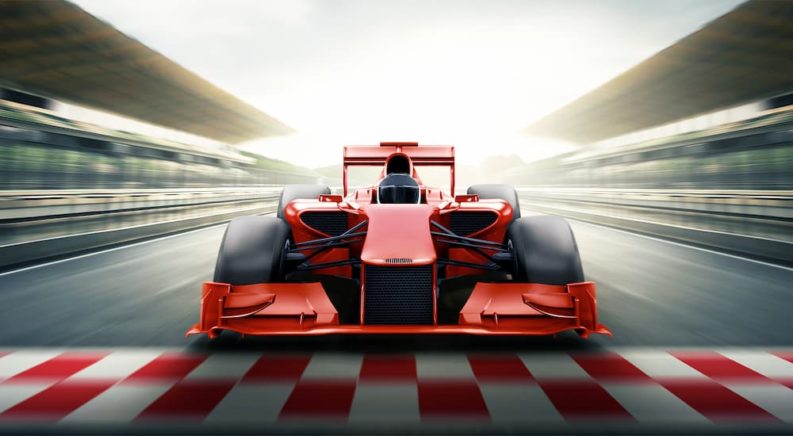On March 17, 2022, a panel consisting of Steve Phelps, Jim France, Rick Hendrick, Jim Campbell, Stu Grant, Pierre Fillon, and John Doonan made a remarkable announcement at Sebring: NASCAR had established a plan to make a return to the 24 Hours of Le Mans in 2023, 47 years after American stock cars last thundered along the Mulsanne Straight. Sadly, Les Deux Monstres, as they were nicknamed by the French media, fared poorly in the 1976 24 Hours of Le Mans. That is why a super team of racing’s biggest names has linked up to ensure that NASCAR fields a competitive product this time around and to expose the European fanbase to the best that NASCAR’s Next-Gen stock car has to offer.
Naturally, France asked Rick Hendrick to bring his team’s dynastic talents to the NASCAR entry for Le Mans. After cleaning up Cup Championships across the last two decades and already winning half of this year’s races, the owner of Hendrick Motorsports is more than excited to be participating. Indeed, the same can be said of Chevy and Goodyear––VP of Chevy Performance Jim Campbell and GM of Global Racing Tires for Goodyear Stu Grant pointed out that both organizations are very familiar with success at Le Mans. Chevy brings two decades of highly competitive experience with Corvette Racing––including racing at Le Mans––while Goodyear is just coming off a two-and-a-half-year development cycle for the Next Gen tires and is salivating at the opportunity to use Le Mans to fine-tune its product.
IMSA President John Doonan is excited to be participating from an administrative perspective, seeing this opportunity as an important next step to further the alliance between the American International Motor Sports Association (IMSA) and the French Automobile Club de l’Ouest (ACO) that recently enabled the same cars to participate in both organizations’ events. ACO President Pierre Fillon may be the most excited of all, as this partnership aims to deliver racing’s greatest collaborative presentation in the 10th year of his leadership, the 10th year of his Garage 56 initiative, and the 100th running of the 24 Hours of Le Mans. That’s a lot of significant anniversaries to celebrate at once, and the prospect of doing so with racing’s greatest collaboration is too good to miss! But for me, the announcement raised one question that echoed louder than the others: what is Pierre Fillon’s Garage 56?
How Many Garages Does He Need?!
Despite the way it might sound, Garage 56 is not an indicator of how Fillon’s personal car collection is stored (a 56 car garage sure paints a strange picture, doesn’t it?). Rather, it refers to the 56th entry to the 24 Hours of Le Mans––classically a field of 55. Garage 56 was established for the 2012 running of Le Mans to lean into the race’s history as a live-action laboratory for testing the latest automotive technology. In the modern era, Fillon wanted to promote that spirit of innovation without taking the place of a traditional car or making the team feel the need to compete with more conventional racers, so the Garage 56 class-of-one was created.
These cars are subject to no technical regulations except those pertaining to safety; however, the emphasis is to explore fuel savings and carbon emissions reduction opportunities (not to produce a vehicle that embarrasses the LMP1 class). The strict approval criteria and steep budgets inherent in developing a car that meets them mean that although this is the 10th year of Garage 56, the Next Gen Camaro would only be the 5th Garage 56 vehicle. Its history, while providing important context for the significance of the initiative and the company that the Camaro would be placed in, is also surprisingly dramatic.
2012 – The DeltaWing
With a front track width of 2 feet, the DeltaWing was a major departure from conventional race car design. Conceptualized as an Indy Car by Ben Bowlby before being pitched to Le Mans organizers, then realized with help from Nissan, the DeltaWing emphasized fuel efficiency without sacrificing performance. Half as heavy, significantly more aerodynamic, and devoid of any prominent wings or canards (relying solely on the underbody to produce downforce), it could achieve the same speeds as normal Indy Cars with substantially lower fuel consumption. The car performed well, earning attention and adoration from fans before a collision during its 75th lap took it out of the race. However, this would not be the last that Le Mans heard of the DeltaWing.
2013 – GreenGT LMP-H2
Using the typical Le Mans Prototype body, the Swiss GreenGT LMP-H2 was meant to use a hydrogen fuel cell powertrain, making it a perfect selection for Garage 56 as the first alternative-fuel car to take on the epic event. Sadly, it was instead the first Garage 56 candidate that was forced to withdraw from the race before it ever began. In GreenGT’s case, the complicated power system was taking too long to fine-tune properly, and the vehicle just wasn’t ready in time. As we’ll see, having a spot in Garage 56 is far from sufficient to guarantee a spot on the track––significant funding and technical challenges must be overcome just to make the starting line. While it’s often disappointing, it also serves to further elevate those teams who successfully field an entry.
2014 – Nissan NISMO ZEOD RC
The hybrid Nissan NISMO ZEOD RC, dressed in white, was the yin to the black DeltaWing’s yang. Using the same body style––most notably, the signature narrow front track and downforce-producing underbody––Nissan and Ben Bowlby were actually sued by the DeltaWing consortium for violating intellectual property rights established with the original DeltaWing race car! Who said that all the drama would be on the track? Speaking of which, the ZEOD RC made some of that happen, too––it cracked 300 km/h and completed the first all-electric lap of the Circuit de la Sarthe. However, the car blew a gearbox and was forced to retire after just five laps.
2016 – SRT41 Morgan LMP2
After 2015 went without a suitable Garage 56 candidate, 2016 delivered in a huge way. Led by quadruple amputee Frédéric Sausset, the SRT41 team’s Morgan LMP2 could be modified in less than 10 minutes to enable Sausset to drive with pedal controls connected to his thighs and the steering column attached directly to his right limb. Although Garage 56 entries do not count on the official standings for the race, and the 315 laps completed were only good enough for 38th of 44 finishing vehicles, the accessibility-oriented team entered history as the first––and to date, only––Garage 56 initiative to finish the 24 Hours of Le Mans!
2017 – Welter Racing BioFuel Car
The Welter Racing name rose to prominence in the ’90s, claiming the first car to crack 400 km/h (249 mph) on Mulsanne Straight and winning the class in 1993. Their revival for an entry to Garage 56 was to be a biomethane-fueled racer, using fuel made from human waste and stored in cryogenic tanks to maximize fuel mass to power the vehicle. Funding sadly ran out before development could be completed, and the new powertrain would not come to fruition before the passing of designer Gérard Welter in early 2018.
Fortunately, however, the work would not go entirely to waste (pun intended)––engineers from the project and experienced Le Mans drivers were brought onboard to develop the stunning VISION Automobiles Paris “1789” hypercar using a biofuel powertrain, which VAP reportedly hoped to showcase in the 2023 Garage 56 slot. However, no sources after April 2020 mention this intent, and VISION has not responded to requests to comment, so a biofuel race car remains a science fiction endeavor.
2018 – Green4U Panoz Racing GT-EV
The Green4U Panoz Racing GT-EV was supposed to use a swappable battery with a 100-mile range and a tandem style LMP body. You may recognize the Panoz name from their involvement with DeltaWing––small world, right? However, in February 2018, the ACO announced that “there will not be a Garage 56 entry this year because there is no serious project.” Ouch. I’m not sure why it didn’t pan out––though it seems to have been a combination of development delays and lack of funding––but whatever the reason, it appears that the ACO pulled the plug for Green4U and Panoz instead of the other way around, adding another dramatic chapter to Garage 56’s legacy.
2021 – SRT41 Graff Oreca 07-Gibson
Originally slated to be the 2020 entry, the second Garage 56 spot to be awarded to SRT41 was postponed to 2021 after the onset of the COVID-19 pandemic disrupted the team’s ability to prepare effectively. While this derailed their plans to be the first full team of drivers with disabilities to compete at Le Mans––amputee Snoussi Ben Moussa was not on the team in 2021, replaced by able-bodied driver Matthieu Lahaye––it still furthered SRT41’s “A Steering Wheel for All” initiative by putting Takuma Aoki and Nigel Bailly behind the wheel. Both drivers had been paralyzed from the waist down in motorcycle accidents, so the car could be fitted with a steering wheel that had pedal controls built-in, which was easily replaceable with a standard steering wheel for their able-bodied teammate.SRT41 delivered yet again in 2021, improving upon their first result by completing 334 laps and finishing 32nd out of 44 cars in a race where the overall winner ran 13 laps fewer than in 2016.
I don’t want to ignore the fact that the accessibility-oriented modifications delivered by SRT41 surely faced significantly fewer hurdles than the one-of-a-kind powertrain designs which failed to make it to race day. But the simple truth is, in a class-of-one race focused on innovation, only one team has produced a viable race car that was able to finish the race in a decade, and they’ve done it twice.
A Legacy to Live For
The NASCAR proposal for 2023 is a strong one. The support of the ACO’s president should go a long way to communicating the legitimacy of their application, although invitations to participate in the race won’t be sent until next year. NASCAR President Steve Phelps has vocalized the intent of the sport to set itself apart from other leagues and increase its reach at the same time. While Bill France Sr put NASCAR on the international racing map in 1976, the failure of either car to finish the race leaves a significant feather missing from the cap of America’s favorite racing league. This presents a prime opportunity for the leaders of each of these organizations to proclaim to the world that they’ve got the best designs, the best teams, and the best race cars, just like up-and-coming manufacturers did throughout the early decades of automotive development.
There’s a ton of work to do. A NASCAR stock car can’t just hop from Daytona to Le Mans without intense modification, as was proven in 1976. From adapting the chassis to deal with a circuit that runs on country roads and implementing proper onboard lighting to ensuring that the powertrain can handle a 24-hour slugfest, Garage 56 entrants have their work cut out for them even when they have a great race car to start with. Of the seven Garage 56 candidates thus far, only four have made it to race day, and only two completed the race.
However, Goodyear, Chevy, and Hendrick Motorsports represent the best of the best in American racing, and with collaborative support from three partnered racing leagues––NASCAR, IMSA, and the ACO––Jim France has put himself in an excellent position to tie off this loose end from his father’s legacy and establish a direct connection for NASCAR to Europe in an age where NASCAR is destined for change. In short, the 10th year of Garage 56 and the 100th year of the 24 Hours of Le Mans just might become the most significant racing event in a century.




